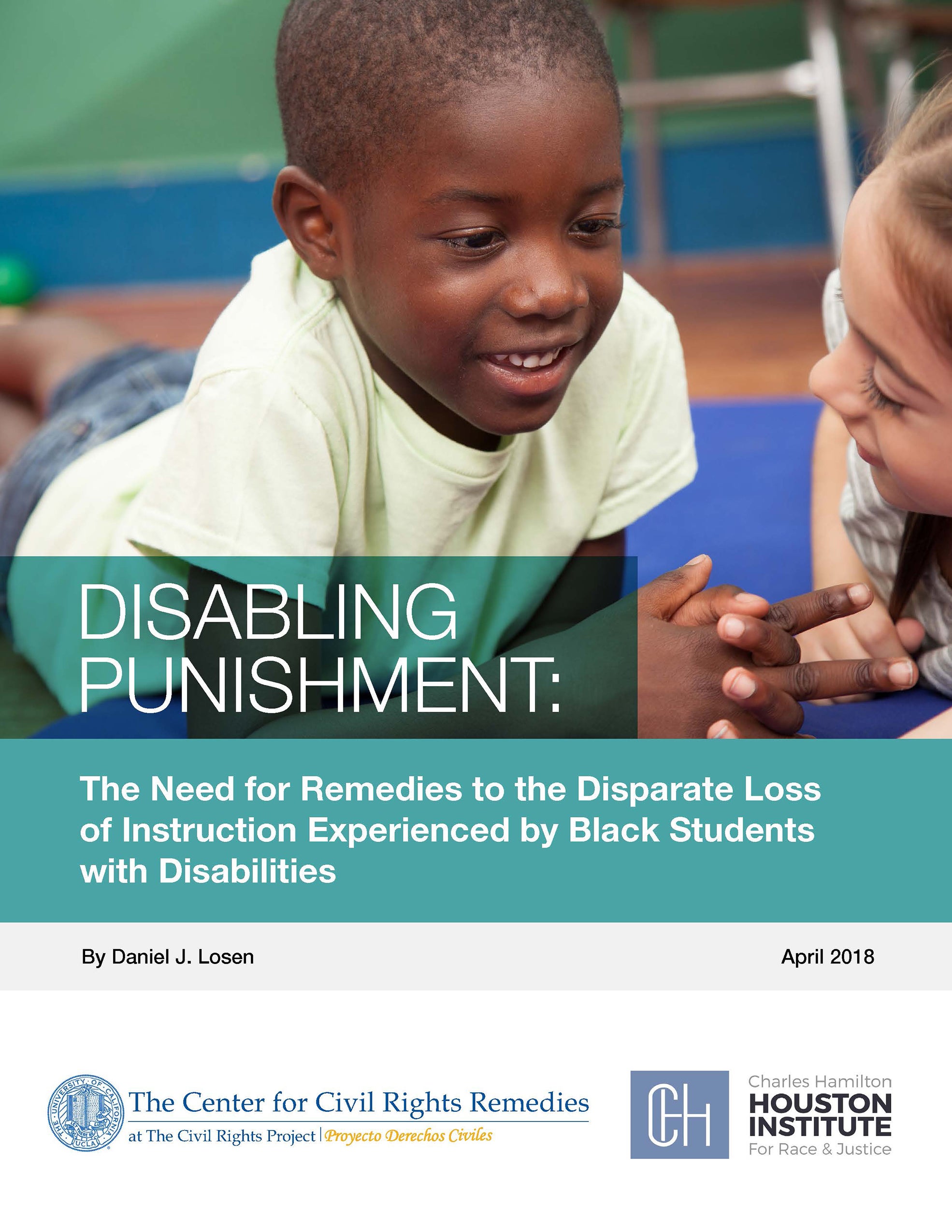 A new report providing the first state-by-state estimate of lost instruction due to discipline for black and white students with disabilities finds dramatic disparities in suspensions by race. The study, called “Disabling Punishment: The Need for Remedies to the Disparate Loss of Instruction Experience by Black Students with Disabilities,” was conducted by the Charles Hamilton Houston Institute for Race & Justice at Harvard Law School (CHHI) and UCLA’s Center for Civil Rights Remedies at The Civil Rights Project.
A new report providing the first state-by-state estimate of lost instruction due to discipline for black and white students with disabilities finds dramatic disparities in suspensions by race. The study, called “Disabling Punishment: The Need for Remedies to the Disparate Loss of Instruction Experience by Black Students with Disabilities,” was conducted by the Charles Hamilton Houston Institute for Race & Justice at Harvard Law School (CHHI) and UCLA’s Center for Civil Rights Remedies at The Civil Rights Project.
While research has documented the impact of exclusionary school discipline practices on other student groups, the educational experience of black students is unique. This report, “Disabling Punishment,” documents disparities faced by a particularly vulnerable group of black students–children with disabilities.
Among students with disabilities, black students tend to be suspended many times more often than their white peers. Nationally, these disparate rates translate into approximately 77 more days of lost instruction for black students with disabilities than their white counterparts. The difference in days of lost instruction means there are huge inequities in the opportunity to learn, according to the report.
“Federal law mandates that all children with disabilities receive a free and appropriate education. This study shows that, contrary to settled law, far too many school districts are punishing and pushing out black students with disabilities,” said Tomiko Brown-Nagin, faculty director of CHHI and the Daniel Paul Professor of Constitutional Law at HLS. “These districts should be held accountable for their failures to help these students learn and thrive.”
Among the study’s findings:
- Blacks lost more than 107 days per 100 enrolled than their white peers in each of the five states with the largest differences in lost instruction.
- In Nevada, for example, in 2015-16, black students with disabilities lost 209 days of instruction per 100 enrolled, which was 153 more than the number lost by white students with disabilities.
- According to the analysis of the federally reported data from 2015-16, the racial discipline gap among students with disabilities increased between blacks and whites, and in at least 28 states.
“We hope the information in this report will serve as a call to action to educators and advocates in every state,” said Daniel Losen, director of the Center for Civil Rights Remedies. “There are no excuses for states to ignore these profound disparities.”
Provisions within the Individuals with Disabilities Education Act (IDEA) require states to review racial discipline disparities at the district level and also require the state authorities to tell the districts flagged for discipline disparities to reserve funds for comprehensive coordinated early intervening services and to attempt to find and address the underlying issues.
The study was prompted by the U.S. Department of Education’s decision in February 2018 to seek comments on its intention to delay implementation of the IDEA regulations that pertain to racial disproportionality in special education, which include disciplinary disparities. During the delay period, the DOED will decide whether to rescind or replace the regulations that were approved in 2016.
The Trump administration has made clear its intention to rescind the school discipline guidance regarding racial disparities in school discipline as well as the IDEA regulations. Consequently, CHHI and the Center for Civil Rights Remedies believe there is an urgent need to call attention to the disparate impact on the opportunity to learn.
The report includes a series of recommendations for state-level stakeholders, education policymakers, and civil rights advocates, and for groups representing parent organizations and teachers’ unions. The recommendations, which are available in the Executive Summary and the Disabling Punishment Report, include:
- Identify districts that have problematic racial and disability disparities in discipline and engage state level administrators in supporting districts to conduct root-cause analyses and redirect IDEA funds toward affecting a remedy;
- Revise codes of conduct and other disciplinary practices to reduce the use of removal from the classroom, except as a measure of last resort, and provide safeguards to ensure that implementation of the changes does not implicate safety;
- Set aside the resources needed for leadership and staff training and for intervention programs that will address the excessive and disparate loss of instruction;
- Use school climate surveys, behavior incident reports, and other monitoring to ensure that school reforms are improving the conditions of learning;
- Dedicate resources to evaluating reform efforts;
- Invest in the collection and public reporting of accurate, timely data on discipline at the district and school levels, including disaggregating the days of lost instruction for all subgroups.
